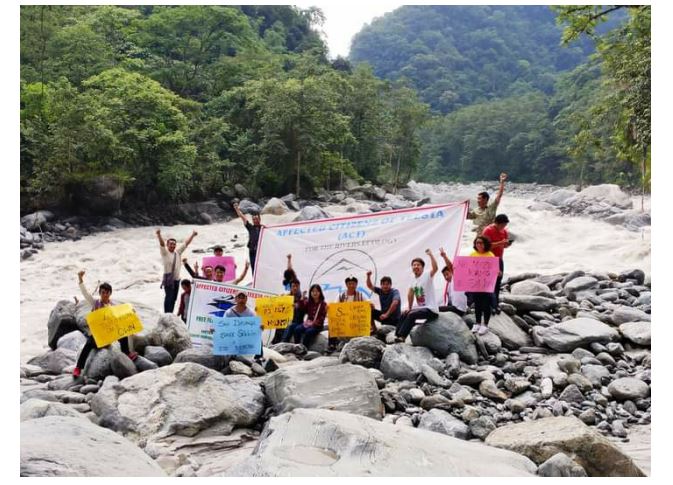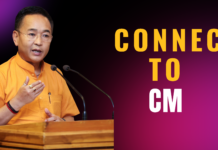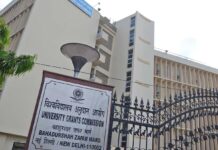Affected Citizens of Teesta (ACT) established in early 2004, has been at the forefront when coming to opposing and raising voices against the destructive developmental programs, especially dams. ACT is an organisation consisting especially indigenous people of Sikkim, Lepchas, formed after coming up of dams in Dzongu. ( Dzongu is a reserved place for Lepchas declared by the 11th chogyal of Sikkim, Tashi Namgyal,
as per notification of 1956. People from outside Dzongu has to obtain a permit to get inside Dzongu from the administration.)
Since its inception, the organisation has been very vocal about raising issues of dams and their impact around.
The movement gained momentum after 2007 when ACT decided to go for the hunger strike, led by both from the side of young and old generations; Dawa Lepcha, Tenzing Gyatso Lepcha, and many others, for 915 days (June 22nd, 2007- September 27th, 2009). After which ACT was able to scrap four dams in the state. This was one of the successful movements by the indigenous people counted around the world. The movement continued even after 2009 in a soft way voicing concerns but yet again it was reinstated in the ground after 2016 under the guidance of ACT’s co-founding members, NGOs, Women’s SHG groups, elected Village Councils, and Civil
society groups.
The movement was renewed after the state government decided to reintroduce Teesta Stage IV dams in Dzongu built and operated by the state-owned corporate, NHPC, one of the most controversial companies.
In early 2020, just a few months after coming up of new government under the direction of Shri Prem Singh Tamang, the Sikkim Krantikari Morcha(SKM) party had led a massive campaign promising to stop building dams in the Holy land of Lepchas, was seen by many as going back to their promises made during the election. In March 2020, CM Tamang met with the chairman of NHPC after which the company had released a press statement stating ‘CM has given full assurance in completion of Teesta Stage IV’. But as soon as this statement came to light ACT flagged off the campaign on social media under the name “SaveTeesta” whereby people from different backgrounds and different parts of the state-supported the organisation. Social media was flooded with counterattacks filled with handles like #saveteesta, #stopstageiv, etc…
Such was the pressure that CM Office had to come out in the open to clarify the statement and said, ‘fabricated one’. To get clarification openly from the CMO isn’t an easy task.
Teesta Stage IV project is in itself a very controversial project in many ways, it is going to be a dual tunnel project each of 6km and 5.6km, the first of its kind in the country or you can even say the experimental project of the dual tunnel. Why this dual tunneling is problematic and controversial is because the Himalayas are made out of the young fold Mountain and consists of a very fragile ecosystem, full of rich biodiversity moreover region falls under seismic zone stage
IV.
Teesta Stage IV comes under a radius of 10km within Kanchendzonga National Park, a UNESCO recognised biosphere reserve in July 2017, this violates the code of national park reserves. Besides, such environmental and ecological perspectives this Teesta River is extremely important to the indigenous community, Lepchas and it holds a religious significance too.
It is considered to be a very sacred river, they believe that once Lepcha dies their soul is taken back to the lap of their ancestors in the Kanchendzonga, Lepchas doesn’t believe in the concept of hell and heaven, and at that time this very River Teesta, which Lepcha called it as Ronggyong, will guide the soul to its place.
In the same way, Mutanchi Yuntandokpun (MYDP), a community club, one of its infamous quoted quotes reads “Teesta is our asylum, tranquillity, identity & pride. She proudly presents the distinctiveness of us who resides in the land where she flows.”
This reveals how sacred the River Teesta is not just for the Lepchas but also for the whole Sikkimese.
ACT in the fight is advocated by many international communities and organisations like; UNESCO, International Rivers, International Peoples Movement for Self Determination and Liberation(Philipines, United Nations Declaration on Rights of Indigenous Peoples, Fridays for Future and various other local, regional groups like Sikkim Progressive Youth Forum (SPYF), DLYA and people living in the downstream of River Teesta, Rafting association…etc

organisation to join the save river Teesta campaign)
Mr. Shanker Sharma, Sikkim Progressive Youth Forum’s CEC wrote on his personal Facebook handle on the backdrop of ACT completing its 14 years of environmental activism; “I feel they have not received the support they deserve from the rest of the people. Their representatives have betrayed them time and again. There have been attempts to divide people, create proxy conflict among the people. The leaders have been detained, tortured, and harassed. Unfortunately, we see their struggle as only theirs. But their fight is not just for themselves but for the entire Sikkim and the global at large. Man’s exploitation of nature is a burning international issue, recklessness may lead to the extinction of life on earth.”
ACT hopes to come over this stage iv dam ( and stop the fifth dam in the way) and remains optimistic. Recently, state Forest minister’s latest interview with The Hindu, he was caught stating “The widening of roads to Nathu La, which is of strategic interest to us (bordering China), and the hydel power plants in north Sikkim, should also take into account the environmental concerns of locals. We are not against such activities, but it should not come at the cost of our biodiversity, ACT has warmly welcomed his statement.
ACT General Secretary, Gyatso Lepcha, on his Facebook handle has wrote
“ACT welcomes the Forest Minister’s statement !!! tiny Sikkim is home to 27% of India’s flowering plants revealed by the Botanical Survey of India !!! the most interesting and fantastic piece of news is that on the occasion Forest Minister of the State (Shri Karma Loday) made a very interesting and deeply measured statement this validates the protest that ACT has been doing against the construction of a dam in Teesta River Basin, particularly North Sikkim… we thank the minister for keeping the facts surrounding the challenges to our fragile state’s ecology. We look forward to better ecology of the state !”
‘SaveTeesta’ campaign has been launched with the massive involvement of youths.
A new team of ACT has been formed led by Mr Sandup Lepcha as president and many
youth-oriented wings have been created too; social media wings, Cultural & artist wings, student wings…etc On the sideline of the SaveTeesta campaign, I interacted with the young minds of ACT and tried to know about their thoughts on the ongoing campaign.
‘Since I have taken birth in this land, Dzongu, it’s my utmost duty or I must say it’s my love for my motherland and secondly, I have seen the sufferings of my elders my parents struggling for our land so I feel as a second-generation I should give my shoulders to them now..’ Says Kingchum Lepcha, a college student hailing from Hee Gyathong, one of the many places which are going to get affected by the Teesta Stage IV.
An interesting fact is that Hee-Gyathong GPU has rejected Stage IV by not allowing the FRA to get passed in the village council meeting.

If this Teesta Stage IV is actually constructed then it endangers the River Teesta, the very last free-flowing stretch of Teesta will be damaged too. Similar concerns were expressed by Rungnyuu Lepcha, another youth involved in the movement, ‘No one would want to witness their motherland being sold, nor I. We do not want to live every day, in fear of the consequences which might be brought by the dam.
Most importantly, the last stretch of Teesta which flows freely right now will not flow as it does, which eventually may lead River Teesta to perish in the future.’
Rungnyuu Further added “River Teesta is an identity to the whole State and not just of cultural importance to the Lepcha tribe”
It’s a sad fact that we are really out here trying to convince the people of our own state to join us in the movement for our Teesta which has given us, the people of Sikkim so much. We should be coexisting with nature.
“We should look up sustainable development.’ One of the youth said.
‘Teesta is not just a river but emotions and if Teesta remains our identity sustains.
River Teesta is equally important as Mt.Kanchenjunga and as holy as the river Ganga as considered by Hindus. When the Kanchenjunga expedition was allowed people stood up to protect our Kanchenjunga but shouldn’t we people come forward and protect our Rivers as we did to protect our mountains?’ Sangay Chopel, a college student, hailing from an affected valley due to coming up of Teesta stage III at Chungthang quoted and questioned.
Sangay also feels strongly against the Teesta Stage Iv because he says, ‘… its the last stretch of Free-flowing portion of river Teesta and geographically when we look into our mountains and landforms it’s not that strong enough to hold such water capacity (referring to reservoir). But what it does is, it destroys the ecosystem and submerges the main fertile land where people mostly grow their cash crops.’
The same kind of issue of the reservoir, Mr. Wangchuk Bhutia, a feature writer of Talk Sikkim had pointed out in his November 2015 article. He wrote “But the people affected by the Teesta Stage V reservoir are experiencing it in real, with their safety and durability of life and property threatened. There seems to be no sincere and concerted effort, either from the state authorities or from the NHPC officials, to find a long-lasting and effective solution to the challenges and risks to life and property being experienced, almost daily, by the people living by the NHPC Teesta Stage V.’
On being asked about, how ACT’s activism is different from the past Kingchum replies, ‘well I would say ACT during past years have done a very commendable work nevertheless they have done with the fullest of their capacity and their limits .so now it’s our time what I have seen is that there is a mixture of many young innovative minds giving creative ideas for the protest.
Like we are going through every aspect, right from legal matters to educating individuals from every nooks and corner of State. and I also would like to add we should not forget the leaders of past though we are advancing even then youths can walk faster but elders know the road. Coming off more youth is like adding up another finest upgradations in the spaceships.
Mingmar Ongkit, a student of NBBG College from L. Dzongu residing near Tung Kyong Dhu [lake] mentions ‘My commitment towards this movement is 100% and ready to bear any consequences if tomorrow government pushes this dam.
Tung Kyong Dhu is a very sacred lake for the Lepcha clan called Hee-Youngmingmoo.
Lake accommodates a very unique kind of fish, it is believed that the population of the Hee-Youngmingmoo clan plunges or expands according to the number of fishes present in the lake. Stage IV endangers this very lake because tunnels run below this lake and people fear that the lake will get dry up because of the seepage.

Many have questioned, especially the pro-government party, about ACT activism and not providing an alternative to the government but it has been a long-known fact that ACT has been trying to convince the government to declare the last free-flowing stretch of Teesta as “river sanctuary and its peripheries as butterfly hotspot area” one of a kind in the country.

Today, ACT isn’t just an organisation fighting to save our rivers and fragile ecosystem from disastrous development but has become an institution and people from outside are willing to hear and learn from the struggles of ACT.
“Dzongu, Sikkim in Northeast India. The land of the Lepcha (Indigenous Peoples) – beautiful and rich in biodiversity. All are under threat with the construction of the Teesta IV hydropower dam. The Lepcha are leading the fight to stop the project under the Affected Citizens of Teesta and Save Dzongu. If successful, this would be the 5th dam the communities have stopped since 2010. The IPMSDL was privileged to have visited and met with some of the affected villages. The Lepcha and their oneness and struggle are inspiring for other people in struggle.” _Beverley Sakongan L. Longid, Global Coordinator, IPMSDL (Philippines), wrote after visiting Dzongu.
Also, Read – Assam- Mizoram Border Dispute, 6 killed





